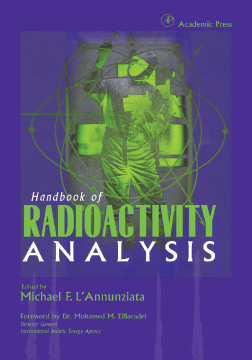
Additional Information
Book Details
Abstract
Handbook of Radioactivity Analysis is written by experts in the measurement of radioactivity. The book describes the broad scope of analytical methods available and instructs the reader on how to select the proper technique. It is intended as a practical manual for research which requires the accurate measurement of radioactivity at all levels, from the low levels encountered in the environment to the high levels measured in radioisotope research. This book contains sample preparation procedures, recommendations on steps to follow, necessary calculations, computer controlled analysis, and high sample throughput techniques. Each chapter includes practical techniques for application to nuclear safety, nuclear safeguards, environmental analysis, weapons disarmament, and assays required for research in biomedicine and agriculture.
The fundamentals of radioactivity properties, radionuclide decay, and methods of detection are included to provide the basis for a thorough understanding of the analytical procedures described in the book. Therefore, the Handbook can also be used as a teaching text.
- Includes sample preparation techniques for matrices such as soil, air, plant, water, animal tissue, and surface swipes
- Provides procedures and guidelines for the analysis of commonly encountered na
"The aim of the authors--to write a practical work that includes both principles and applications of modern radio analytical techniques--has been achieved. [Recommended to] upper-division undergraduates through professionals." --CHOICE, 1999
"This book, written by experienced specialists, covers the basic principles and, most importantly, the practical aspects of the radioanalytical methods that are in widespread use. ...The book not only serves as a reliable guide to the use of well-established methods, but also draws attention to recent developments, thus providing new and stimulating ideas for readers who may regard themselves as already knowledgeable in the field." --ANGEWANDTE CHEMIE, 1999
"...the information in the text is exquisitely presented and very readable... . Excellent applications to current research problems are given. There is also a good index and table of radioactive isotopes, the latter being very useful in such a book. The major strength of this book is its in-depth coverage of scintillation analysis and its prolific use of figures, diagrams, and tables." --ANALYTICAL CHEMISTRY, 1999
"This book is a practical handbook in line with the current trend of radiation measurement. The content is organized as follows. The 1st Chapter: Nuclear radiation, its interaction with matter and radioisotope decay; the 2nd Chapter: Gas ionization detectors (ion chambers, proportional detectors, GM counters); the 3rd Chapter: Semiconductor detectors; the 4th Chapter: Radiotracer liquid scintillation analysis; the 5th Chapter: Environmental liquid scintillation analysis; the 6th Chapter: Statistical computations in counting; the 7th Chapter: Sample preparation techniques for liquid scintillation analysis; the 8th Chapter: Cherenkov counting (by liquid scintillation analysis); the 9th Chapter: Solid scintillation analysis; the 10th Chapter: Flow scintillation analysis; the 11th Chapter: Radioisotope imaging; the 12th Chapter: Robotics and automation in radiochemical analysis and Appendix: Table of radioactive isotopes. As is clear from the title, the coverage of this book is limited to the analysis of radiation from radioisotopes. While it includes even very specific techniques of analysis, the content is quite easy to understand as each specific field is treated by its respective specialist. The description and explanation are well harmonized throughout the entire book and a number of articles are quoted for ease of reference to the readers. It is remarkable that liquid scintillation analysis has two separate chapters devoted to sample preparation and environmental sample analysis. Listing the latest developments extensively, this book is definitely useful not only to specialists but also to those wishing to have an overview of the current status of radioisotope analysis." --MAKOTO TAKIUE, Ph.D., Radioisotope Research Center, Jikei University School of Medicine
"For the experienced scientist, and for many novices, this handbook will offer a treasure trove of advice and ideas of the anaylsis of radioactivity. . . .it is a valuable reference work and should find its way onto the shelves of university libraries." --TRENDS IN ANALYTICAL CHEMISTRY, VOLUME 18, 1999
